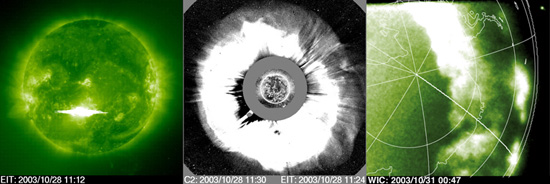Magnetic Reconnection: A Universal Process
On October 28 and again on October 29, a massive active region on the Sun erupted, producing major x-ray flares and ejecting giant clouds of plasma and magnetic fields at high speeds into the inner solar system. As the coronal mass ejections (CMEs) slammed into Earth's magnetic field, they triggered intense geomagnetic storms, convulsing the magnetosphere with powerful substorms and triggering brilliant auroral displays over the north and south poles.

Images of the 2003 "Halloween" events. Left: SOHO EIT image of the X17 flare erupting from active region 486; center: composite LASCO/EIT image showing the earthward-directed halo CME; right: false-color image of the aurora australis acquired with the auroral imager on the IMAGE spacecraft.
Magnetic reconnection, which taps the energy stored in a magnetic field and converts it to heat and kinetic energy in the form of charged particle acceleration and large-scale flows of matter, was at the heart of each of these events -- the flare, the CME initiation, the transfer of energy from the CME and solar wind to the magnetosphere that produced the magnetic storms, and the explosive release of energy in magnetospheric substorms.
Reconnection occurs universally in plasmas, the electrically conducting mixes of positively and negatively charged particles that account for an estimated 99% of the observable universe. Besides its role in eruptive flares/CMEs and magnetospheric disturbances, magnetic reconnection has been invoked in theoretical models of a variety of astrophysical phenomena including star-accretion disk interaction, pulsar wind acceleration, and the acceleration of ultra-high-energy cosmic rays in active galactic nuclei jets. Reconnection occurs in man-made as well as natural settings, in fusion machines (tokamaks, spheromaks) and in laboratory reconnection experiments.
"Unfreezing" the magnetic field
|